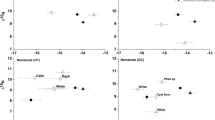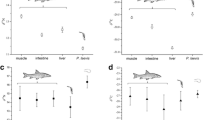Abstract
Nitrogen isotopes have been widely used to investigate trophic levels in ecological systems. Isotopic enrichment of 2–5‰ occurs with trophic level increases in food webs. Host–parasite relationships deviate from traditional food webs in that parasites are minimally enriched relative to their hosts. Although this host–parasite enrichment pattern has been shown in multiple systems, few studies have used isotopic relationships to examine other potential symbioses. We examined the relationship between two gut-nematodes and their lizard hosts. One species, Physaloptera retusa, is a documented parasite in the stomach, whereas the relationship of the other species, Parapharyngodon riojensis (pinworms), to the host is putatively commensalistic or mutualistic. Based on the established trophic enrichments, we predicted that, relative to host tissue, parasitic nematodes would be minimally enriched (0–1‰), whereas pinworms, either as commensals or mutualists, would be significantly enriched by 2–5‰. We measured the 15N values of food, digesta, gut tissue, and nematodes of eight lizard species in the family Liolaemidae. Parasitic worms were enriched 1±0.2‰ relative to host tissue, while the average enrichment value for pinworms relative to gut tissue was 6.7±0.2‰. The results support previous findings that isotopic fractionation in a host–parasite system is lower than traditional food webs. Additionally, the larger enrichment of pinworms relative to known parasites suggests that they are not parasitic and may be several trophic levels beyond the host.


Similar content being viewed by others
References
Barrett J (1981) Biochemistry of parasitic helminths. Macmillan, London
Boag D, Neilson R, Robinson D, Scrimgeour CM, Handley LL (1998) Wild rabbit host and some parasites show trophic-level relationships for delta 13C and delta 15N: a first report. Isotopes Environ Health Stud 34(1–2):81–85
Bronstein JL (1994) Our current understanding of mutualism. Q Rev Biol 69(1):31–51
Dearing MD (1993) An alimentary specialization for herbivory in the tropical whiptail lizard Cnemidophorus murinus. J Herpetol 27(1):111–114
DeNiro MJ, Epstein S (1981) Influence of diet on the distribution of nitrogen isotopes in animals. Geochim Cosmochim Acta 45(3):341–351
Deudero S, Pinnegar JK, Poulnin NV (2002) Insights into fish host–parasite trophic relationships revealed by stable isotope analysis. Dis Aquat Organ 52(1):77–86
Gannes LZ, O’Brien DM, del Rio CM (1997) Stable isotopes in animal ecology: assumptions, caveats, and a call for more laboratory experiments. Ecology 78(4):1271–1276
Hare PE, Fogel ML, Stafford TW Jr, Mitchell AD, Hoering TC (1991) The isotopic composition of carbon and nitrogen in individual amino acids isolated from modern and fossil proteins. J Archeol Sci 18(3):277–292
Herre EA, Knowlton N, Mueller UG, Rehner SA (1999) The evolution of mutualisms: exploring the paths between conflict and cooperation. Trends Ecol Evol 14(2):49–53
Hobson KA (1993) Trophic relationships among high Arctic seabirds: insights from tissue-dependent stable-isotope models. Mar Ecol Prog Ser 95(1–2):7–18
Hobson KA, Welch HE (1992) Determination of trophic relationships within a high Arctic marine food web using delta-13C and delta-15N analysis. Mar Ecol Prog Ser 84(1):9–18
Iken K, Brey T, Wand U, Voigt J, Junghans P (2001) Food web structure of the benthic community of the Porcupine Abyssal Plain (NE Atlantic): stable isotope analysis. Prog Oceanogr 50(1):383–405
Iverson JB (1982) Adaptations to herbivory in iguanine lizards. In: Rand G (eds) Iguanas of the world: their behavior, ecology, and conservation. Noyes Publications, Park Ridge, New York, pp 60–76
Kohler P, Voigt WP (1988) Nutrition and metabolism. Springer, Berlin Heidelberg New York
Macko S, Estep M (1983) Microbial alteration of stable nitrogen and carbon isotopic compositions of organic matter. In: Annual Report of the Director of the Geophysical Laboratory, Carnegie Institution of Washington, DC, pp 394–398
McCutchan JH Jr, Lewis WM Jr, Kendall C, McGrath CC (2003) Variation in trophic shift for stable isotope ratios of carbon, nitrogen, and sulfur. Oikos 102(2):378–390
Nagy KA (1977) Cellulose digestion and nutrient assimilation in Sauromalus obesus, a plant eating lizard. Copeia 1977(2):355–362
O’Grady SP, Morando M, Avila L, Dearing MD (2005) Correlating diet and digestive tract specialization: examples from the lizard family Liolaemidae. Zoology 108(3):201–210
Olive PJW, Pinnegar JK, Polunin NVC, Richards G, Welch R (2003) Isotope trophic-step fractionation: a dynamic equilibrium model. J Anim Ecol 72(4):608–617
Pinnegar JK, Cambell N, Poulnin NVC (2001) An evaluation of host–parasite relationships in fishes, using stable isotopes of nitrogen and carbon. J Fish Biol 59:494–503
Post DM (2002) Using stable isotopes to estimate trophic position: models, methods and assumptions. Ecology 83(3):703–718
Post DM, Pace ML, Hairston NG Jr (2000) Ecosystem size determines food-chain length in lakes. Nature 405(6790):1047–1049
Pryor GS (2003) Roles of gastrointestinal symbionts in nutrition, digestion, and development of bullfrog tadpoles (Rana catesbeiana). PhD dissertation, Zoology, University of Florida, Gainesville, Florida
Pryor GS, Bjorndal KA (2003) Symbiotic nematodes accelerate metamorphosis in bullfrog tadpoles. In: Proceedings of the Society for Integrative and Comparative Biology Annual Meeting, New Orleans, Louisiana, January 2003, vol 43, issue 6, p 1000
Robbins CT, Felicetti LA, Sponheimer M (2005) The effect of dietary protein quality on nitrogen isotope discrimination in mammals and birds. Oecologia 144(4):534–540
Sponheimer M, Robinson T, Ayliffe L, Roeder B, Hammer J, Passey B, West A, Cerling T, Dearing D, Ehleringer J (2003) Nitrogen isotopes in mammalian herbivores: hair d15N values from a controlled feeding study. Int J Osteoarchaeol 13(1–2):80–87
Zimmerman LC, Tracy CR (1989) Interactions between the environment and ectothermy and herbivory in reptiles. Physiol Zool 62(2):374–409
Acknowledgments
S.P.O’G. was supported by a teaching assistantship from the University of Utah, USA, and this study was funded by a grant in aid of research awarded to S.P.O’G. from the Society for Integrative and Comparative Biology. M.D.D. was supported by NSF IBN 0236402. The authors wish to thank Mariana Morando and Luciano Avilla for their assistance in obtaining samples and Matt Sponheimer, Kent Hatch, Adam West, Naomi Levin, Ben Passey, David Post, and the anonymous reviewers for their critical and helpful comments. Additionally, much is owed to Thure Cerling for the use of his laboratory and Joseph Griggs for the sample preparation. Trapping permits were provided by the fauna authorities of the Catamarca, San Juan, Chubut, and Neuquen provinces of Argentina. This experiment was conducted in accordance with the current laws of the United States of America and Argentina.
Author information
Authors and Affiliations
Corresponding author
Additional information
Communicated by David Post
Rights and permissions
About this article
Cite this article
O’Grady, S.P., Dearing, M.D. Isotopic insight into host–endosymbiont relationships in Liolaemid lizards. Oecologia 150, 355–361 (2006). https://doi.org/10.1007/s00442-006-0487-z
Received:
Accepted:
Published:
Issue Date:
DOI: https://doi.org/10.1007/s00442-006-0487-z




